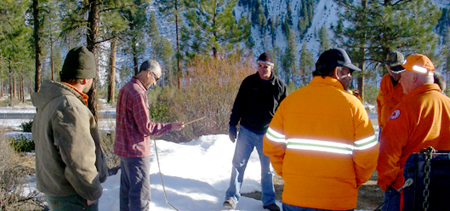
| CONNECTIONS |
IDAHO
ITD
HOME
511 TRAVEL SERVICES
IDAHO
DMV
ITD
NEWS
HIGHWAY
SAFETY
IDAHO STATE POLICE
STATE OF IDAHO
NIATT
NATIONAL
AASHTO
AAMVA
AAA of IDAHO
FEDERAL HIGHWAYS
FEDERAL AVIATION
IDAHO STATE POLICE
NHTSA
NTSB
TRB
U.S. DOT
TRANSPORTER
Archives
Milestones
Comments
Idaho
Transportation
Department
Office of Communications
P.O. Box 7129
Boise, ID 83707
208.334.8005
Fax: 208.334.8563

Refresher training helps prepare for winter avalanche season

 Whether it snows a little or a lot across Idaho each winter, one thing you can count on is a succession of snow slides along notorious “avalanche alley” in District 3. The 11-mile section of Idaho 21 between Banner Summit and Grandjean Junction, called Canyon Creek, has 54 avalanche chutes along its steep slopes, contributing about 90 percent of the state’s avalanches.
Whether it snows a little or a lot across Idaho each winter, one thing you can count on is a succession of snow slides along notorious “avalanche alley” in District 3. The 11-mile section of Idaho 21 between Banner Summit and Grandjean Junction, called Canyon Creek, has 54 avalanche chutes along its steep slopes, contributing about 90 percent of the state’s avalanches.
On Dec. 2, the ITD Avalanche Office conducted a one-day refresher for District 3 & 4 personnel at the Lowman Fire Station. The avalanche training began with a detailed Power Point presentation explaining the different types of avalanches, how to mitigate them and how to conduct rescue efforts.
Emphasis was on the Idaho 21 corridor. In addition, two meteorologists from the National Weather Service based in Boise presented an overview of how they collect weather data, and how that data is combined with information from ITD’s weather stations to more accurately predict avalanches.
The afternoon session included hands-on practice in the use of avalanche beacons, probes and rescue devices. More than 20 ITD employees attended the course. Employees who completed the training are sanctioned to enter the Canyon Creek Corridor during closure periods.
Know more about Idaho 21 and the avalanche corridor:
-
Highway 21 was first paved in 1969, but was closed all winter every year until Gov. Cecil Andrus asked ITD to become more proactive in 1986; at his urging, ITD began looking for new ideas to keep the highway open.
-
It cost the department approximately $219,000 to keep Idaho 21 open last season
-
The user-cost incurred by the public as a result of a 30-day closure is estimated to be $243,000.
Published 12-18-09